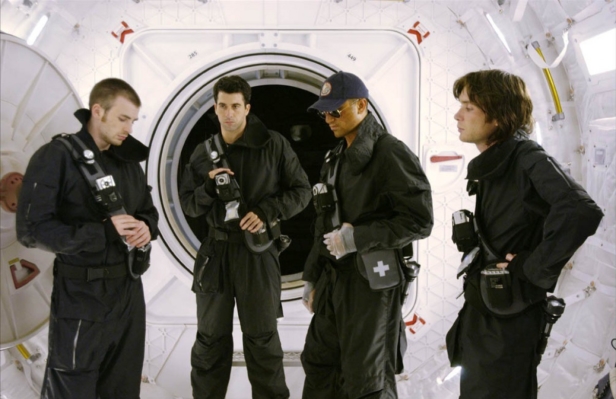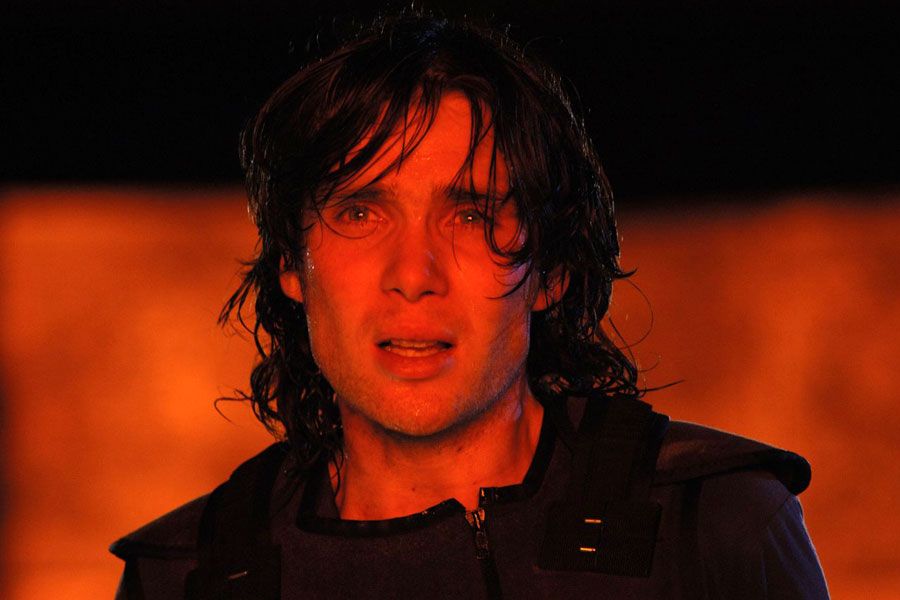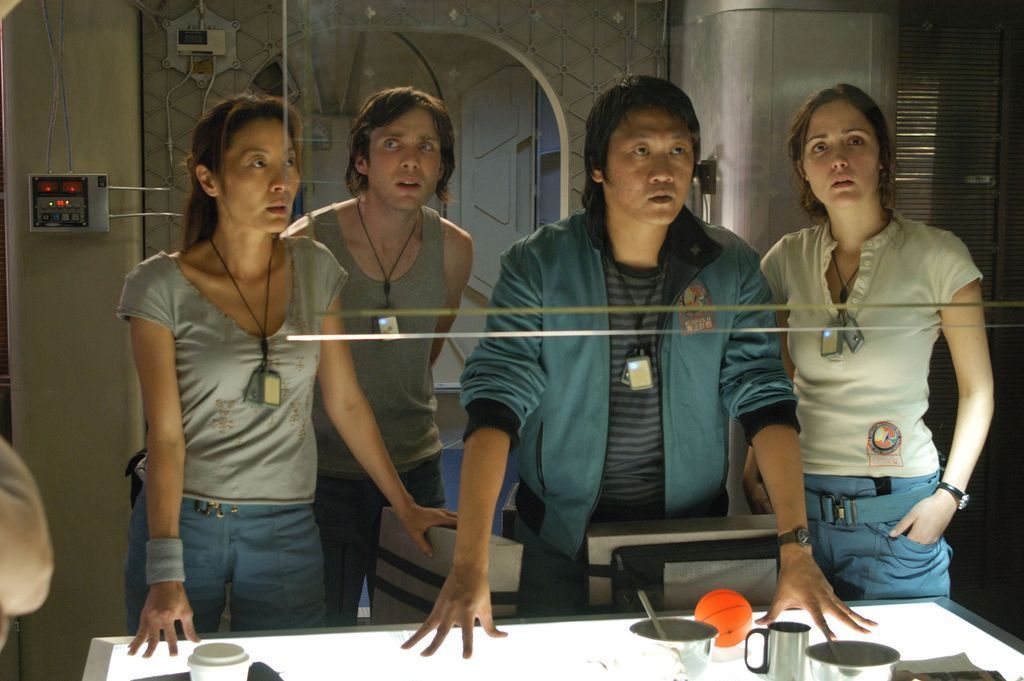We speak to Cliff Curtis, Troy Garity and Hiroyuki Sanada about being part of the crew of Danny Boyle’s introspective sun-saving space thriller Sunshine…
It’s 2057 and our sun is dying. Humanity’s last hope remains with a crew of eight astronauts onboard the international spacecreft Icarus II. Their mission: to restart the sun with a nuclear payload the size of Manhattan Island. And to paraphrase a line from the movie, uttered by Chris Evans’ Mace: “There is literally nothing more important than completing that mission. End of story.”
“The principle… that’s the thing that is keeping us all alive and that we’re all completely dependent on, is in jeopardy [is] the maximum vulnerability you can ever imagine for mankind,” considers director Danny Boyle during the DVD commentary to his 2007 space odyssey.
The stakes are indeed high and for the crew of Icarus II the British filmmaker assembled an impressive international ensemble cast that now, a decade on, reads like a roll call of some of our biggest contemporary screen stars: Rose Byrne, Cliff Curtis, (a post Human Torch but impending Captain America) Chris Evans, Troy Garity, Cillian Murphy, Hiroyuki Sanada, Benedict Wong and Michelle Yeoh.
Akin to Ridley Scott’s original Alien, (one of the films that Sunshine clearly aspires to) establishing a convincing group dynamic amongst this eclectic company was of crucial importance to ensure believability. Boyle had the actors bunk together in the dormitories of the University Of East London to allow these relationships to develop organically.
“That was probably the best part as we got to know each other due to living in such close quarters,” recalls Troy Garity, who played communications officer Harvey, to SciFiNow. “This film is about people spending years together in these long metallic cylinders being thrust into the galaxy, so under those circumstances you get to know each other intimately and instinctively.”
Playing the captain on this death mission was Hiroyuki Sanada, who recently returned to the genre as the pilot of the space station in science fiction horror Life. “We had small rooms, no TV, no refrigerator but a shared kitchen and every night one of us had to cook for everyone,” remembers the actor who plays Kaneda. “That rehearsal period helped create the atmosphere that we’d spent a long time in this spaceship together. We created that sense of teamwork already. On-set we just lived and breathed the role as Danny wanted to create the realism of living there as a character.”
But this was only part of Boyle’s strategic pre-production process. The director curated cast screenings that included such referential classics as Das Boot, Alien and the nerve-wracking 1953 adventure The Wages Of Fear, which foreshadows Sunshine somewhat with its premise concerning truck drivers transporting a ton of dynamite across hazardous terrain. To help plunge themselves into their environment, Boyle’s cast also embarked on team excursions including scuba diving to experience weightlessness and flight- simulated space training. They were also subjected to lectures from celebrated physicist Dr Brian Cox, (who served as Sunshine’s scientific consultant and wrote all the characters’ back stories), a futurist with regards the technology they would be using onboard and an array of other experts in the fields of biology, chemistry and even permaculture.
“It was one of the best preps I’d ever done on a movie, ever!” enthuses future Fear The Walking Dead star Cliff Curtis, who portrayed the ship’s psychologist Searle. “It’s really great when you have six weeks to immerse yourself in the world of that film as it becomes filled with anticipation, excitement and focus.”
But all the training and social interaction in the world would be meaningless if the characters weren’t relatable onscreen too. Fortunately Alex Garland’s attentive script, under Boyle’s assured direction allowed the entire cast a chance to shine. “My character’s role as psychologist was to look at the human error and understand the psychological and emotional pressure,” continues Curtis.
“It’s a death mission; so that’s going to weigh psychologically. To manage the human element of the operation was Searle’s responsibility.”
Searle also had a noticeably unique connection and seeming obsession with the sun – exposing himself to greater levels of its energy in a computer- controlled observation room. “I start to look at the biological effects of getting so close to the sun and then start to discover that it actually has an affect on the psyche,” he continues.
This latter point links to an understanding regarding the consequences of the ill-fated Icarus I, which was the first ship to attempt the mission seven years earlier but mysteriously disappeared. As we later learn, that ship’s captain, Pinbacker (Mark strong), became so consumed by the singular focus of the mission that he ended up jeopardising it. Interestingly, Curtis points out that Pinbacker and Searle are two opposing sides of the same coin. “[He] was a captain obsessed with the purpose of the mission. My character is a scientist and a medical doctor, so he’s got a more objective view of the affects of the sun on the self. He can manage where the line is between staying on mission or not. [Pinbacker] didn’t have the same medical discipline to measure his psychological profile.”
After discovering the distress beacon of Icarus I, it is Searle who puts together a convincing risk assessment-based case for altering the ship’s trajectory to rendezvous with the abandoned space vessel and commandeer its nuclear payload. The reasoning is that two bombs (and thus two chances at reigniting the sun) are better than one. Unfortunately navigator Trey (Benedict Wong) forgets to realign the shields protecting Icarus II from the sun, which results in severe damage to their spacecraft.
The first character to prove their dedication becomes Kaneda, the captain of Icarus II, who sacrifices himself for the mission by fatally repairing the ship’s damaged shields. It demonstrates a code of honour that is quintessentially Japanese. “I thought it’s a great sacrifice at that point that relates to the Japanese spirit; like a samurai for instance. Sacrificial death is the most beautiful thing in traditional Japanese culture,” says Sanada.
Pivotal to the absence of this character being felt by the cast, Sanada was told to leave the set and not return upon completion of his final scenes. “Danny and the producer said: ‘Go back to LA – you cannot stay anymore,’” reveals the actor. “This was because they wanted the other actors to feel that Kaneda was gone – totally gone. That was important. ‘Don’t come back and say hi!’” he laughs. “Again it was about capturing that realism and that was part of Danny’s direction.”
An Icarus II crew member that had trouble accepting the mission’s grim parameters was second-in-command Harvey. The communications officer reluctantly becomes the acting captain following Kaneda’s demise. “I was told that my character didn’t obey [the] scientific reasoning that the likelihood of returning to earth alive was slim to none,” explains Garity. “[His] emotional brain secretly didn’t accept that and he hadn’t dissolved himself from worldly possessions and wanted to return to his family. The other scientists had given themselves to the greater good. Harvey starts to become unhinged with that desire to survive over accomplishing the mission.”
This inadvertently leads to Harvey’s own demise whilst fleeing Icarus I via the airlock. It also leads to an unexpected return for a now heavily sun-scorched and homicidal Pinbacker that breaks with the comparative narrative realism up until that point and became a source of critical contention. “It bent the genre a bit at the end but i didn’t understand the criticism,” considers Garity. “I always felt that Pinbacker was human weakness…he was this ego that he couldn’t let go of. Harvey would’ve turned into him had he been left alone in the ship and gone crazy with radiation.”
Indeed Boyle saw Pinbacker as a character spiritually connected to the renegade colonel Walter E. Kurtz from Joseph Conrad’s
seminal novel Heart Of Darkness, famously portrayed by Marlon Brando in Francis Ford Coppola’s Apocalypse Now. “Pinbacker began to identify himself as God,” continues Garity. “When you’re flying into the sun and all you do is fear, [and he] philosophies about the life-force of our galaxy, you begin to identity the sun actually as God as opposed to God being everything, which goes against the scientific mind.”
Despite the honourable literacy antecedents, critics at the time were sensitive to the sudden change in tempo from serious sci-fi to something (perhaps harshly) comparable to an outer space slasher/monster horror movie. Arguably Pinbacker allows for a deeper introspective reading of the film however. He’s a character made insane by confronting the terms of humanity’s own relatively pointless existence, believes that the human race isn’t important enough to save and that nature (or science) should ultimately run its course.
Sunshine wasn’t a big financial success following its release in 2007 but, in the years since, it has arguably acquired warmer cult classic admiration. “I’m shocked that more people didn’t see it,” laments Garity. “I like to think it’s a great sci-fi film and i see remnants of it in current science fiction. some of the deeper questions that it raises are: ‘What is god?’ ‘What are we really?’ And is that an algorithm or is that ego?”
“Alex Garland has a very strong mind for asking meaningful questions and Danny Boyle isn’t shy of going there and is up for that level of enquiry,” considers Cliff Curtis. “To pose those questions: the meaning of life and the fatality of life and existentialism, man versus science, science of man versus the factor of the universe… that stuff stands up and you’ve got to take it seriously.”
“The mission is fiction of course but has a reality,” adds Hiroyuki Sanada. “The set design was real and the camera work had a gracefulness. Danny has a great sense for the music too (by Underworld). Even though it was a space story the enemy wasn’t the alien – the enemy was human beings and [therefore] it’s very philosophical.”
But in reality is this seemingly extreme sun-losing scenario a possibility and would you be able to reignite it? Regrettably it is and unfortunately you cannot, however the timeframe to ‘lights out’ is more elongated. “It can’t last forever, it’s losing an unimaginable amount of fuel – six hundred mission tonnes of fuel every second,” confirms Dr Brian Cox during his DVD commentary. “But we think it’s got enough left, because it’s so big, [to last] five billion years.” Well, that’s more reassuring!
This article first appeared in SciFiNow issue 135.
Sunshine is available on Blu-ray from Twentieth Century Fox. Get all the latest sci-fi news with every issue of SciFiNow.



